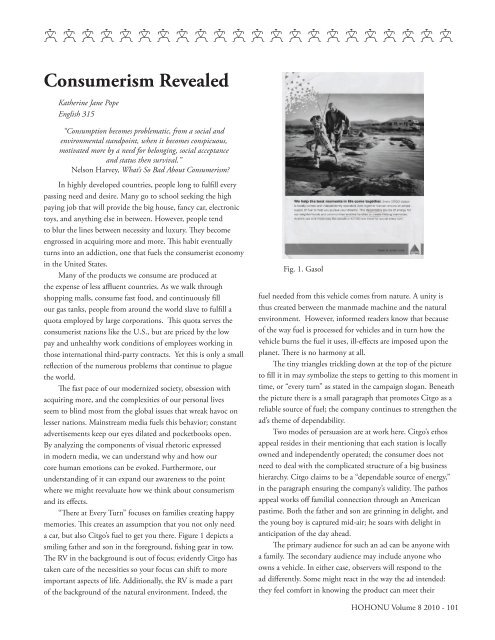A JOURNAL OF ACADEMIC WRITING VOLUME 8
A JOURNAL OF ACADEMIC WRITING VOLUME 8
A JOURNAL OF ACADEMIC WRITING VOLUME 8
Create successful ePaper yourself
Turn your PDF publications into a flip-book with our unique Google optimized e-Paper software.
d d d d d d d d d d d d d d d d d d d d d d<br />
Consumerism Revealed<br />
Katherine Jane Pope<br />
English 315<br />
“Consumption becomes problematic, from a social and<br />
environmental standpoint, when it becomes conspicuous,<br />
motivated more by a need for belonging, social acceptance<br />
and status then survival.”<br />
Nelson Harvey, What’s So Bad About Consumerism?<br />
In highly developed countries, people long to fulfill every<br />
passing need and desire. Many go to school seeking the high<br />
paying job that will provide the big house, fancy car, electronic<br />
toys, and anything else in between. However, people tend<br />
to blur the lines between necessity and luxury. They become<br />
engrossed in acquiring more and more. This habit eventually<br />
turns into an addiction, one that fuels the consumerist economy<br />
in the United States.<br />
Many of the products we consume are produced at<br />
the expense of less affluent countries. As we walk through<br />
shopping malls, consume fast food, and continuously fill<br />
our gas tanks, people from around the world slave to fulfill a<br />
quota employed by large corporations. This quota serves the<br />
consumerist nations like the U.S., but are priced by the low<br />
pay and unhealthy work conditions of employees working in<br />
those international third-party contracts. Yet this is only a small<br />
reflection of the numerous problems that continue to plague<br />
the world.<br />
The fast pace of our modernized society, obsession with<br />
acquiring more, and the complexities of our personal lives<br />
seem to blind most from the global issues that wreak havoc on<br />
lesser nations. Mainstream media fuels this behavior; constant<br />
advertisements keep our eyes dilated and pocketbooks open.<br />
By analyzing the components of visual rhetoric expressed<br />
in modern media, we can understand why and how our<br />
core human emotions can be evoked. Furthermore, our<br />
understanding of it can expand our awareness to the point<br />
where we might reevaluate how we think about consumerism<br />
and its effects.<br />
“There at Every Turn” focuses on families creating happy<br />
memories. This creates an assumption that you not only need<br />
a car, but also Citgo’s fuel to get you there. Figure 1 depicts a<br />
smiling father and son in the foreground, fishing gear in tow.<br />
The RV in the background is out of focus; evidently Citgo has<br />
taken care of the necessities so your focus can shift to more<br />
important aspects of life. Additionally, the RV is made a part<br />
of the background of the natural environment. Indeed, the<br />
Fig. 1. Gasol<br />
fuel needed from this vehicle comes from nature. A unity is<br />
thus created between the manmade machine and the natural<br />
environment. However, informed readers know that because<br />
of the way fuel is processed for vehicles and in turn how the<br />
vehicle burns the fuel it uses, ill-effects are imposed upon the<br />
planet. There is no harmony at all.<br />
The tiny triangles trickling down at the top of the picture<br />
to fill it in may symbolize the steps to getting to this moment in<br />
time, or “every turn” as stated in the campaign slogan. Beneath<br />
the picture there is a small paragraph that promotes Citgo as a<br />
reliable source of fuel; the company continues to strengthen the<br />
ad’s theme of dependability.<br />
Two modes of persuasion are at work here. Citgo’s ethos<br />
appeal resides in their mentioning that each station is locally<br />
owned and independently operated; the consumer does not<br />
need to deal with the complicated structure of a big business<br />
hierarchy. Citgo claims to be a “dependable source of energy,”<br />
in the paragraph ensuring the company’s validity. The pathos<br />
appeal works off familial connection through an American<br />
pastime. Both the father and son are grinning in delight, and<br />
the young boy is captured mid-air; he soars with delight in<br />
anticipation of the day ahead.<br />
The primary audience for such an ad can be anyone with<br />
a family. The secondary audience may include anyone who<br />
owns a vehicle. In either case, observers will respond to the<br />
ad differently. Some might react in the way the ad intended:<br />
they feel comfort in knowing the product can meet their<br />
HOHONU Volume 8 2010 - 101
















